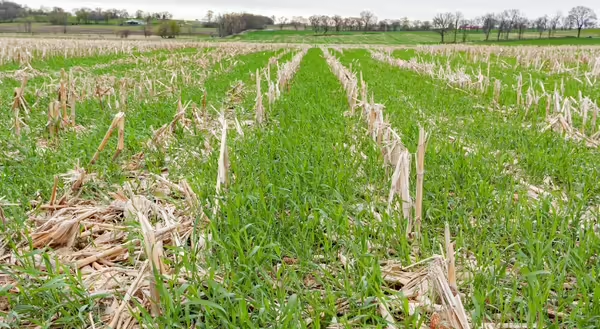
Harvest is well underway across the state, with record yields projected for both corn and soybean. Many farmers are also gearing up to plant their winter cover crops. In recent years, cereal rye has emerged as a popular choice among farmers, both those new and experienced with cover crops. On this blog we’ve discussed the benefits of cover crops and how to select the right cover crop for your operation. This post will highlight cereal rye, including its characteristics, how to plant it, manage it, and terminate it.
Characteristics
Cereal rye (Secale cereale) is a cool season annual grass. There are many species of ryegrass, so it is important to pay attention to the seed tag and make sure you are selecting the right one for you. Cereal rye (also called winter rye) should not be confused with annual rye (Lolium perenne sp. multiflorum) and perennial rye (Lolium perenne sp. perenne). These are different plants with different growth characteristics.
Cereal rye is winter-hardy, which means it will survive through our cold winters in Northern Illinois. It can be seeded later in the fall than many other cover crops, so it fits well in a standard corn/soy rotation. Cereal rye establishes quickly and easily (even in poorer quality soils) and is relatively inexpensive, which has led to it becoming a popular cover crop with those new to planting them. Cereal rye will pause its growth in the winter and quickly resume growth in the spring. It also pairs nicely with other grass or legume cover crops in a mix.
Benefits
Cereal rye has many benefits: it is an excellent soil builder, reduces erosion and nutrient runoff, scavenges nitrogen, increases soil organic matter, increases water infiltration, and suppresses weeds. Cereal rye has a very dense, fibrous root system (similar to some of our native prairie grasses) that is fantastic at anchoring soil in place and absorbing excess nitrogen. Cereal rye can hold as much as 100 lbs. nitrogen per acre during the winter, with many studies reporting it capturing over 60% of the residual N left after corn. This makes cereal rye a popular choice of cover crop to plant after corn, before soy.
Planting
Cereal rye is fairly easy to get established and has a lot of flexibility in the planting method used and timing. Cereal rye can be planted later in the fall than most other cover crops, which allows it to fit nicely into a corn/soy rotation. Cereal rye will germinate at temperatures as low as 34°F. Cereal rye can also be interseeded into V3-V7 corn to get a jumpstart on establishment, depending on the herbicide regimen used. Cereal rye can be drilled, broadcast, or aerial seeded. If drilling, plant no deeper than 2 inches at a rate of 60-120 lb/A. If broadcasting, seed at a rate of 90-160 lb/A. Cereal rye can also be included in a cover crop mixture with a legume. If using in a mixture, seed at the lowest recommended rate. To get the most benefits from planting cereal rye as a cover crop, growers should plant as early as they are able to. Earlier planting will allow for more growth in the fall, which maximizes the nitrogen scavenging and erosion control benefits of this cover crop.
Termination
One of the major concerns when using cereal rye as a cover crop is how it will be terminated. It can be terminated with multiple methods — roller-crimping, mowing, tillage, and herbicides. But because of the rapid growth and high biomass production, it can get out of hand quickly in the spring. It is difficult to give a firm termination date, as cereal rye growth and maturity date are impacted by soil moisture and temperature. As with any cover crop, deciding when to terminate is a balancing act between maximizing the benefits of the cover crop and minimizing the difficulty of termination and other adverse effects. One of the common issues seen with cereal rye is that it ties up soil nitrogen as it decomposes. This makes it a challenging cover crop to deal with before corn. It is generally recommended to terminate cereal rye when plants are 6-18 inches tall. The most common termination method used in Illinois is herbicide application – apply the full, recommended rate of glyphosate.
Pros and Cons
Pros | Cons |
| Easy to establish | Can tie up soil nitrogen in the spring |
| Rapid growth | Timing of planting and termination can be challenging |
| Inexpensive | Need to seed earlier if using as a nitrogen scavenger |
| Can be planted in late fall | Pests may overwinter in residue |
| Flexible seeding methods | Can be challenging to terminate |
| Produces a lot of biomass | Produces a lot of biomass |
Emily Hansen is a Commercial Agriculture Educator with University of Illinois Extension, serving Bureau, LaSalle, Marshall, and Putnam counties. Emily provides research-based educational programs that empower growers to make sustainable choices on their farms.
Want to get notified when new Field Notes posts are available? SIGN ME UP!
Armstrong, S., Gentry, L., Schaefer, D., Miller, E., Pike, & Illinois NREC. (2019). Considering Cover Crops?
Midwest Cover Crop Council, University of Illinois Extension, Woodyard, J., Johanning, N., & Armstrong, S. (2019). Post Corn, Going to Soybean: Use Cereal Rye.
SARE Outreach. (2008). Managing Cover Crops Profitably (3rd Ed. ). DIANE Publishing.
USDA Natural Resources Conservation Service. (2022). Rye: Which is Which.